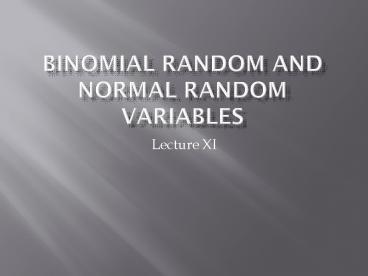Binomial Random and Normal Random Variables PowerPoint PPT Presentation
1 / 20
Title: Binomial Random and Normal Random Variables
1
Binomial Random and Normal Random Variables
- Lecture XI
2
Bernoulli Random Variables
- The Bernoulli distribution characterizes the coin
toss. Specifically, there are two events X0,1
with X1 occurring with probability p. The
probability distribution function PX can be
written as
3
Sum of Two Bernoulli Variables
- Next, we need to develop the probability of XY
where both X and Y are identically distributed.
If the two events are independent, the
probability becomes
4
Transforming the Two Bernoulli Scenario
- Now, this density function is only concerned with
three outcomes ZXY0,1,2. There is only one
way each for Z0 or Z2. Specifically for Z0,
X0 and Y0. Similarly, for Z2, X1 and Y1.
However, for Z1 either X1 and Y0 or X0 or
Y1. Thus, we can derive
5
(No Transcript)
6
Expanding to Three Bernoulli Variables
- Next we expand the distribution to three
independent Bernoulli events where
ZWXY0,1,2,3.
7
Rewriting in Terms of Z
- Again, there is only one way for Z0 and Z3.
However, there are now three ways for Z1 or Z2.
Specifically, Z1 if W1, X1 or Y1. In
addition, Z2 if W1 and X1, W1 and Y1, and
X1 and Y1. Thus the general distribution
function for Z can now be written as
8
(No Transcript)
9
Binomial Distribution
- Based on this development, the binomial
distribution can be generalized as the sum of n
Bernoulli events. - For the case above, n3. The distribution
function (ignoring the constants) can be written
as
10
(No Transcript)
11
Explaining the Constants
- The next challenge is to explain the Crn term.
To develop this consider the polynomial
expression
12
Pascals Triangle
- This sequence can be linked to our discussion of
the Bernoulli system by letting ap and b(1-p).
What is of primary interest is the sequence of
constants. This sequence is usually referred to
as Pascals Triangle
13
1
1
1
1
1
2
1
3
3
1
1
1
4
6
4
14
- This series of numbers can be written as the
combinatorial of n and r, or - Thus, any quadratic can be written as
15
- As an aside, the quadratic form (a-b)n can be
written as
16
- Thus, the binomial distribution XB(n,p) is then
written as
17
Expected Value of Binomial
- Next recalling Theorem 4.1.6 EaXbYaEXbEY
, the expectation of the binomial distribution
function can be recovered from the Bernoulli
distributions
18
(No Transcript)
19
Variance of Binomial
- In addition, by Theorem 4.3.3
- Thus, variance of the binomial is simply the sum
of the variances of the Bernoulli distributions
or n times the variance of a single Bernoulli
distribution
20
(No Transcript)

